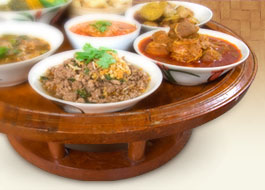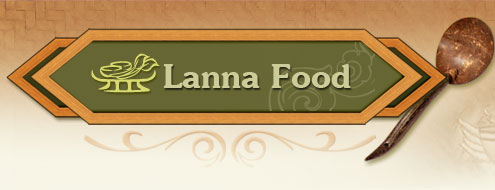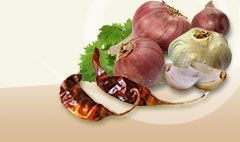Jack fruit |
|
|
 | Artocarpus eterophyllus Lamk. |
|
| |
 | Maraceae |
|
| |
 | Jack fruit |
|
| |
 | Banun, Manun, Maknun (Northern); Mak mi, Bak mi (Northeastern); Khanu (Chanthaburi); (Phak Pnuean Ban A-han Thai, 2005, 182); Nen (Nakhon Ratchasima) (Kanchana Diwiset, et al., 2005, 32) Kha noe (Khamer); Mak mi (Northeastern); Khanu (Chantaburi); Na ko (Malaysian - Pathani); Na Yuai Sa (Karen); Lang (Ngio) (Wut Wuthithamwet, 1997, p. 122); Mak lang (Tai Yai-Mae Hong Son) |
|
| |
 | Khanun comes in quite a variety. The native variety is known as Khanun nang or Khanun poe among Lanna people. They also call it Khanun champa da, Knanun lamut or Khanun hin. (Wut Wuthithamwet, 1997, 122; Rattana Phromphichai and Rangsan Chanta, 1999, 7342). They are recommended for cooking or making soup as they have a firm texture. At present over 50 varieties have been developed and named after the breeder, or their unique fruit or leaves, such as Tha-wai for the all year round fruiting kind, Si Banchong, Thong Sutchai and Champa Krop (Rattana Phromphichai and Rangsan Chanta, 1999, 7342).
Evergreen trees, 8-15 m. high, white resinous latex in all parts, soft wood with a yellow core. Leaves spirally arranged, usually glabrous, elliptic to obovate, cariaceous, 7-15 cm. long, petiole 1-2.5 cm., dark green, smooth and waxy. Inflorescence solitary, axillary, with monoecious flowers, stamen spikes terminal or axillary, cylindrical or clavate 2.5 cm. long, pistillate spikes cauliflory, cylindrical or oblong with a large stem. Syncarp covered by tubercles, sweet smelling; fruiting perriants fleshy, yellow; 10-60 kg. in weight; seeds round and oval, edible (Kanchana Diwiset, et al., 2005, p. 32). The wood heart, called krak, can be mixed with alum to get a yellow dye, if mixed with fabric dying as it contains the color agents Morin & Cyanomaclurin. Grown for food and used as dye. Propagated from seeds. (Wut Wuthithamwet, 1997, 122)
Besides cultivating for fruit and dye, Khanun has an auspicious name whose meaning implies good luck and prosperity as well as security, so all houses will grow at least one tree. Lanna people often make a spicy kind of spicy soup from it called kaeng khanun for such occasions as weddings and New Year to ensure long lasting prosperity and support from friends and family. Its leaves and wood are used in house building ceremonies and other auspicious ceremonies. Its wood is carved into a Buddha image to be dedicated to the temple, which will result in prosperity to the one who dedicates it. The sapling resin is thick and sticky so it is often referred to in Lanna saying Kaeng khanun kon tang implying one who eats Khanun soup tends to sit around for a long time when wooing or courting a woman. (Rattana Phromphichai and Rangsan Chanta, 1999, p. 7343)
|
|
| |
 |

Fiber, calcium, phosphorus, Vitamin C (Phak Phuen Ban A-han Thai, 2005, p. 182) |

Leaves have an astringent or bitter taste. Can be crushed and placed on an abscessing wound. Roots are sweet and slightly bitter, can be taken to improve heart condition, treat venereal diseases, used as a vermifungal, and to treat neurological problems and epilepsy. Sapling has a bitter taste, used to reduce swelling or abscessing boils or sores, lymph glands abscess, as a food its high in starch. (Wut Wuthithamwet, 1997, p. 122). The mesocarp of mature seeds is sweet and fragrant and is good for the heart and is used as a mild laxative or allowed to ferment to make a liquor. Young seeds are oily, can relieve diarrhea, and are boiled or roasted to stimulate the flow of milk in women who have just given birth. The ripe young seeds are used as a mild laxative. (Phak Phuen Ban A-han Thai, 2005, p. 182) |
|
| |
 | All year round |
|
| |
 |
Kanchana Diwiset, et al., Compiler. (2005). Phak Phuen Ban Phak Nuea. Phennapha Sapcharoen, Ed. 2nd ed. Nonthaburi: Center for Development of Traditional Thai Medicine Text. (in Thai). Phak Phuen Ban A-han Thai. (2005). Bangkok: Saengdaet. (in Thai). Rattana Phromphichai. (1999). Nun, Ba. In Saranukrom Wattanatham Thai Phak Nuea (Vol. 14, pp. 7341-7343). Bangkok: The Siam Commercial Bank Foundation for the Encyclopedia of Thai Culture. (in Thai). Wut Wuthithamwet. (1997). Saranukrom Samunphrai: Ruam Lak Pesatchakam Thai. Bangkok: Odean Store.(in Thai). |
|
| |
|
|




